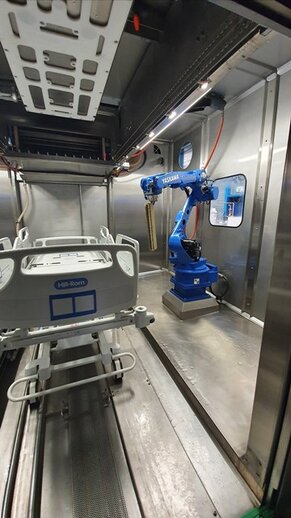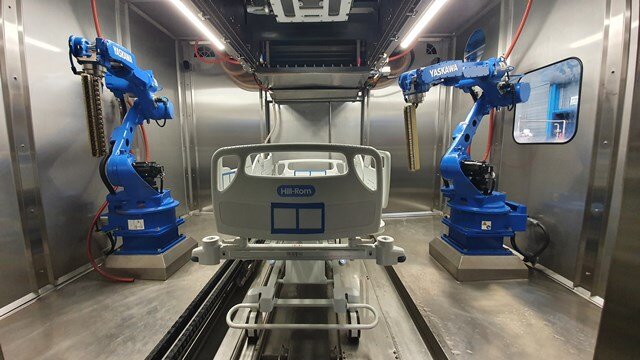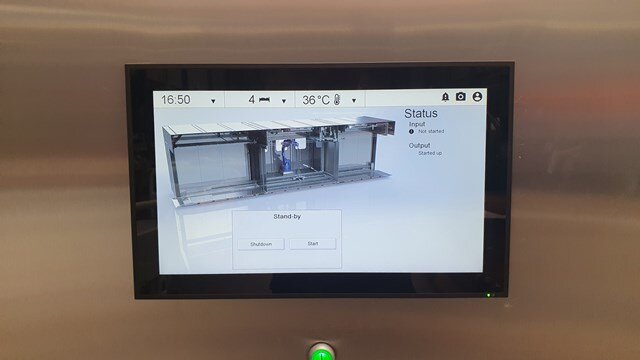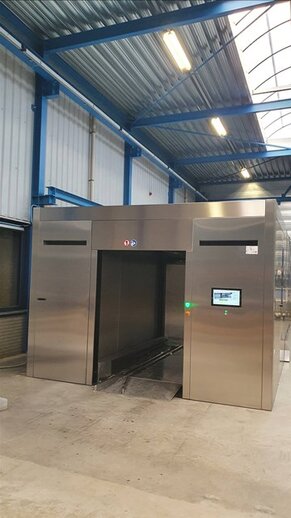Our industry-leading, high-speed industrial robots include high-payload, extended-reach, ultra-maneuverable seven-axis and unique 15-axis dual-arm robots.
Cleaning hospital beds with robots
Weber Hospital Systems is a fairly new company that has been in business since 2017. It is part of Weber Machinebouw, a family business that was founded 61 years ago. In 2014 Weber did a one-off project at the Erasmus Medical Centre in Rotterdam. At that time, hospital beds were still cleaned manually there, a labour-intensive and non-validated process. Normally Weber Machinebouw is active in the metalworking industry but the company took on the project via one of their business relations. It was an interesting project and at this time the idea arose that there might be a larger market for the cleaning of hospital beds. Hospital beds are still mostly cleaned manually, which is expensive, there is often a shortage of people and the result is never 100%. However, automation in hospitals is lagging behind.
Thermal disinfection
Until that time, Erasmus MC cleaned its beds manually with water and chemicals, after having cleaned them mechanically with (chemical) disinfection for several years. Whereas in the Netherlands the guideline is to optically clean hospital beds and mattresses, most European countries require beds to be disinfected. Beds can be disinfected in two ways: with chemicals or thermally. For the project in Erasmus MC, the choice was made to thermally clean the beds using steam.
The machine developed by Weber Hospital Systems consists of a number of cabins. In the first cabin, the bed is identified. Each bed has a code containing the make and model and this is scanned. Then the bed is automatically transported to the washing cabin using a pushing unit. Next, a plate comes down which, by means of vacuum, lifts the mattress to clean it separately from the bed frame. The mattress passes through a sort of "letterbox" and steam is sprayed onto it from all sides. Down in the cabin, the bed is cleaned by the robots.
- Endüstriler
- Metal İşleme Çözümlerimiz
- uygulamalar
- Robotic Inspirations...
- müşteri
- Weber Hospital Systems
- Ürünler
- GP25-12 - GP Serisi
Challenge
The challenge was to get as close to the bed as possible to minimize the loss of temperature of the steam. Weber Hospital Systems felt that the best way to do this was with a robot. The two Yaskawa GP25-12 robots with IP67 protection are equipped with a lance with steam and air nozzles. The robots can work with hot steam as close as possible to all parts of the bed. The water in the steam soaks off the dirt and allows it to drain away while the temperature of the steam kills the micro-organisms. In addition to the steam, high-pressure air is blown to remove the water as quickly as possible. Nowadays, hospital beds contain more and more electronics, such as a built-in scale or Wi-Fi, which would make treatment with a lot of water or chemicals risky. Steam contains very little water and is even suitable for beds with a lot of electronics, such as ICU beds.
200 beds per day
"Getting hospital beds cleaned by people is completely dependent on the person doing it. If the person in question is less motivated that day or does not feel well, the washing is likely to be done more carelessly than usual. With this bed washing machine, every bed is always exactly as clean as it should be," says Erik Sierkstra, Managing Director of Weber Hospital Systems. When the washing programme has finished, the bed moves on to the next cabin. There, the clean mattress is placed back on the bed. The whole process takes about six minutes, which translates into 10 beds per hour and over 200 beds per day.
When Weber decided to further explore this market, the company spoke to many parties, all well-known robot manufacturers were considered. "We wanted to have confidence that we would get good service, maintenance and support, both in the Netherlands and abroad," says Sierkstra. "We also wanted to get as much information as possible out of the system. Because we do a lot of projects abroad, we can't put a mechanic on a plane every time something goes wrong. We want to be able to communicate with the robot remotely and get all the necessary information out of it. This is important from a time and cost point of view"
Yaskawa was already working with several (PLC) software parties and was also open to work with Sigmatek, the software manufacturer Weber works with. A triangle was set up between Yaskawa, Sigmatek and Weber to make sure the machine software could communicate with the robot MotoLogix software. The Yaskawa Teach Pendant is not used for this, but Weber instructs the robots with their own software and is able to get a lot of information from the robots remotely. The fact that Yaskawa was willing to cooperate in this integration was one of the reasons that Yaskawa was chosen.
Local service support
"Last year we really got going and it's starting to gain momentum now. Units 7 and 8 will be ordered in the coming weeks," Sierkstra continues. "The first three machines have now been installed in Denmark, in March the next ones will go to Germany, later to Norway, two more in Denmark and we are in talks with hospitals in Switzerland. Hopefully there will be many more! It's ideal that Yaskawa offers local service support in these countries everywhere."
The name of the machine is VDS: Validated Disinfection System. The VDS is part of the tour of the Erasmus Medical Centre, where 15.000 people work. Even King Willem Alexander has been there twice in recent years and is pictured with the VDS. People like robots. The machine is actually a closed box of stainless steel, but the sides are made of glass, simply so that people can look inside. In the hospital in Denmark, cameras have even been installed and the images can be seen on large video displays in the entrance hall. It's nice to see, shows that patient safety is important and emphasizes the cleanliness and hygiene levels of the hospital.
Machine building with a touch of robotics
Until recently, Weber Machinebouw was mainly active in metalworking, greenhouse construction, automotive and much more. "This was totally out of our comfort zone. We are just simple machine builders from West Friesland and no disinfection specialists. Meanwhile we have hired people with knowledge of that market," says Erik Sierkstra. During this time interest has grown tremendously and Weber Hospital Systems has received a grant from the European Commission to further develop the product. Weber is now in an industry that has some steps to take in terms of automation, steps that Weber Hospital Systems is taking. "With the knowledge we have from mechanical engineering with a touch of robotics and service from Yaskawa."























